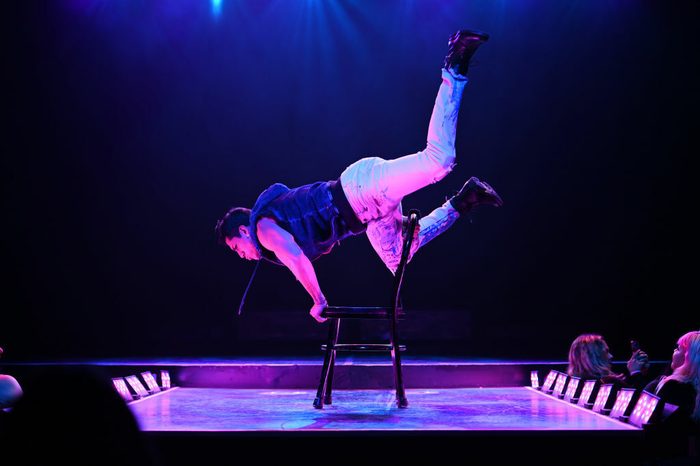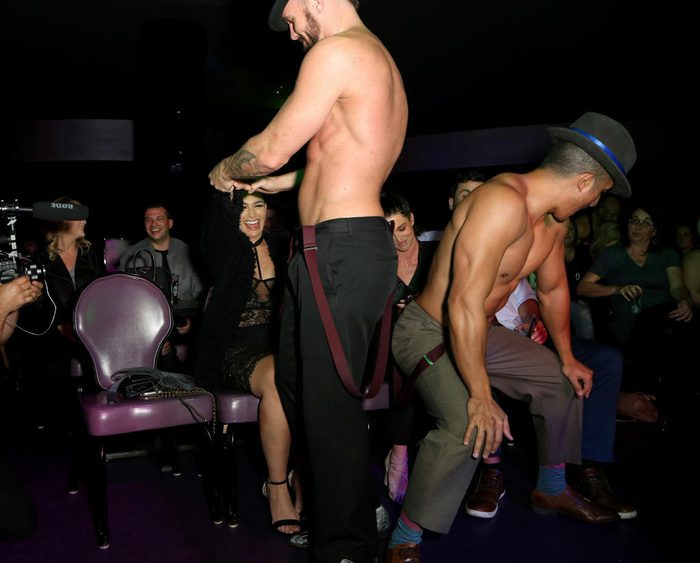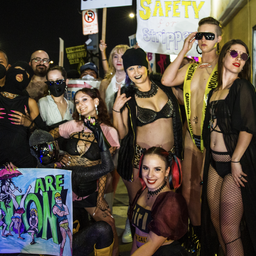
Las Vegas is very much a union town. In September, after decades of work from UNITE HERE’s Culinary Workers Union, hotels and restaurants on the Las Vegas Strip officially became 100% unionized, drawing a celebratory visit from Acting Secretary of Labor Julie Su and winning a historic wage increase for 4,000 workers at the Venetian Resort.
Just off the Strip, another iconic Vegas workforce just went public with their plans to make a little labor history of their own. The Chippendales — the world’s most famous male revue — have added another accessory to their trademark cuffs and collar: a union card.

On October 8, Chippendales dancers at the Rio announced their intention to unionize with Actors’ Equity Association, a 111-year-old, 51,000-strong union of live entertainers and stage managers. If they win, they will be blazing a trail for other performers on the Strip, where none of the shows except “Menopause the Musical” are unionized, according to Actors’ Equity.

Alex Stabler, who’s worked as a Chippendales dancer for three years, is a veteran of the Las Vegas live entertainment scene. He moved to the city to work with Cirque du Soleil and has spent the past 20 years performing as a dancer and an aerialist. “I was in an incredible show called Le Rêve and then went over to Chippendales because the production value and show had evolved immensely from when I had seen it maybe 15 years ago, when my ex-boyfriend was in it,” Stabler explains.
Once he got the gig, though, he was aghast to be offered the exact same base pay rate that his former partner had been paid 15 years prior — a flat $100 per show. At first, he just sighed and chalked it up to the game. Due to his skills as an aerialist, he was able to negotiate a few extra bucks for himself, but he calculates that his current pay still only comes out to about a $17 hourly wage.
“Being a performer for this long, we’re kind of conditioned to be happy for what we can get,” he says ruefully. “It’s a competitive market. And unfortunately, the entertainment industry breeds this concept of disposability, you know — one in, one out. I think it took somebody like Freddy, who wasn’t necessarily a seasoned performer but had a different background, to really shake it up and create change.”
Freddy Godinez, Stabler’s coworker, husband and business partner, is a relative newcomer to the glittery world of Las Vegas live entertainment. Before donning the Chippendales uniform, he spent ten years working in hotel operations in California while earning a bachelor’s degree from the University of Nevada Las Vegas and an executive master’s in urban planning from the University of Southern California. After Godinez moved to Las Vegas, he found a job as a bartender, and through that was introduced to the Culinary Union. He became a member, and his union education advanced rapidly from there. When he landed at the Rio, Godinez says, he could immediately tell that something wasn’t quite right.
“[In my hotel career], I was director of operations, so I understood the value of creating a culture and environment for my team, my staff, that was a symbiotic relationship,” he explains. “You take care of your employees, your employees are happy, the profit continues, and it’s a constant relationship. So when I saw these disparities here at Chippendales … I was a little confused.”
Godinez and Stabler walk me through a typical night for a Chippendale in the Rio’s $10 million, 400-seat theater. If there’s a pre-show rehearsal scheduled on that day, they’re called in between 5 p.m. and 7 p.m.; rehearsal time is unpaid unless it exceeds 15 hours that week. Once the show starts, a dancer can be expected to perform anywhere from four to ten numbers in a 16 number show, which includes extensive choreographed routines, acrobatic acts like Stabler’s, and lap dances and audience interaction (“Broadway burlesque,” as Stabler describes it). “People think that we’re living the luxe life, with Bentleys and Mercedes, because we’re Chippendales, and when we share the actual reality of it, it’s just kind of like, come again?” Stabler says. “If you’re a new performer at Chippendales and you do eight shows a week, you get $800 before taxes — after taxes, it’s around five-something a week.”
The show itself lasts 80 minutes, and then the performers are required to take photos with audience members afterward. Since the Rio is a casino, tips are not allowed, but guests are charged $35 a photo and encouraged to view it as a token of appreciation for the workers. Of the $35, the performers receive 50 cents. Then, after all that, the Chippendales must spend at least 15 minutes in the theater’s Flirt Lounge bar interacting with guests — ”that means signing photos, talking and hugging, photos — for no additional pay. During company promotional appearances, like when they’re shooting the Chippendales’ yearly calendar or doing TV spots, workers receive $25 per hour for a minimum of two hours.”
The workers are classified as employees but do not receive benefits or sick pay, which is an especially sore subject given the particulars of their workday (imagine how many germs come flying out of those happily tipsy brides-to-be as they’re screaming in appreciation or enjoying a lapdance). There is no Chippendales HR department. Workers are adamant about the need for clearer guidelines and protections for workers’ safety, especially in regards to inebriated guests. On top of that, the brand has a very specific aesthetic that workers are expected to maintain – and those costs add up.
“Right now, the compensation is not enough to support the cost of living for the physical requirements of the job,” touring cast member Chase Roback explains via email. Clothing isn’t provided for their Flirt Lounge time or promotional appearances, so they have to shell out for stylish outfits to keep customers happy. Those canonically hunky, muscular physiques require constant maintenance, too. As Godinez, who’s competed in various fitness competitions, can attest, the necessary diet and training regimen to build and keep that kind of body isn’t cheap.
Factor in the huge amount of physical exertion the show itself requires, the mental and emotional labor demanded by guests who each want to feel like the center of attention, and the high probability of excess alcohol consumption among the various bridal parties and birthdays, and the reality behind the fantasy the Chippendales provide starts to sound just plain exhausting, if not outright nightmarish.
“When I started really calculating the time that I was required to be on call, there’s times where we’re getting paid like $17 an hour, or sometimes less,” Godinez says. “We’re not asking for the moon. We’re not going to come in and say, ‘Give us $1,000 a show.’ We just want what feels competitive and fair for the current state of living.”
The dancers love their jobs in spite of the challenges, so instead of quitting, they’ve decided to chart a new course for the organization. About a year ago, determined to improve their situation, Godinez began talking to Stabler and their roughly two dozen other coworkers about the idea of unionizing.

“There are people in management that have advocated for us, but obviously unsuccessfully,” Stabler says. “Freddy actually allowed people to believe that something could be done. Everybody obviously got excited, because it had felt unreachable for us until Freddy was like, ‘No, there’s actually something we can do.’”
After months of careful, quiet organizing resulted in a “strong supermajority” of about 90% support, they finally felt comfortable going public with the union drive. The night before they sent out the press release, Stabler and Godinez went to speak to management. As they and the other two Chippendales I spoke with all emphasized, their Las Vegas team is small and tightly knit. Each person used the phrase “we’re a family” when describing the relationship between the dancers and their three managers, and their concern about how the union drive might impact those relationships was genuine. “We want to leave things better than we found them, because the brand, our managers, and our cast mates are family to us,” touring cast member Shyllon Melatti told me over email from Europe as he traveled between shows. “We believe this effort will help protect our future while making the show stronger for everyone who is a part of it.”
The workers had wanted their managers to hear the message directly from them, not an email, and for them to understand that their decision was nothing personal. As Stabler says, “It’s not us against Chippendales. We just want to have our voices heard and have things improved because we’ve been trying and asking for so long, and nothing’s happened.”
Despite the dancers’ good intentions, Chippendales management reacted coolly to the news. “They just said, ‘Okay’ — and we were kind of shocked, because we were expecting a big reaction,” Stabler says. The dancers are waiting to hear if management will recognize the union voluntarily, but in the meantime they’re already planning for a union election, and hoping that the company will at least choose to remain neutral as the process plays out.
For its part, the Actors’ Equity Association union is over the moon about its flashy new members. “The entire Las Vegas Equity community is thrilled to welcome the Chippendales into our ranks,” said Marci Skolnick, a veteran Las Vegas stage manager and leader in Actors’ Equity, in a statement. “Actors’ Equity Association is here to help the Chippendales get union contracts, complete with union benefits, that will enable them to make a real living doing what they do best.”
Strippers only recently joined the Actors’ Equity fold in 2023, after a grueling strike and high-profile organizing campaign by workers at the Star Garden Topless Dive Bar in North Hollywood finally ended in union recognition. Since then, workers at another strip club, Magic Tavern in Portland, Ore., unanimously voted to join Actors’ Equity. It’s clear that workers in other parts of the live entertainment industry have been paying close attention to the warm welcome that the union has extended to its newest members.

“We fall perfectly under their umbrella,” says Stabler. “They have represented strippers, which is what we do identify as; we also are professional dancers and performers, and they represent Broadway, so we live somewhere happily, right in between the two.”
The dancers themselves are feeling hopeful and excited about the future — about making changes, winning a seat at the table and making their voices heard. “We are doing this because we love Chippendales; that is first and foremost,” Godinez says. “But things do have to change, and hopefully we inspire others, especially in Las Vegas, to enact change for other shows.”
The word is already spreading through Las Vegas’s backstages and break rooms. Stabler tells me that he’s already lined up half a dozen coffee chats with other live entertainment workers who are eager to learn more about unionizing. “So many people have reached out,” he says, flashing a megawatt smile. “I think the reality is we’re going to be the first, but we don’t want to be the last.”
Kim Kelly is a freelance journalist and author based in Philadelphia, PA. She is a labor writer for In These Times, a labor columnist at Teen Vogue and Fast Company, and regularly contributes to many other publications. Her first book, FIGHT LIKE HELL: The Untold History of American Labor, is now available from One Signal/Simon & Schuster. Follow her on Twitter at @grimkim and subscribe to her newsletter, Salvo, here.











